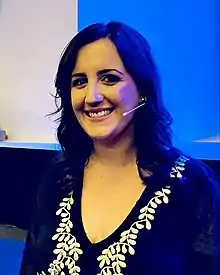María Escudero-Escribano
María Escudero-Escribano (born June 3, 1983) is a Spanish chemist and Director of the Nano-Electrochemical group at the University of Copenhagen. Her research considers the design of materials for catalysis, fuel cells and sustainable chemistry.
María Escudero Escribano | |
|---|---|
 | |
| Born | |
| Alma mater | University of Extremadura Autonomous University of Madrid |
| Scientific career | |
| Institutions | Technical University of Denmark University of Copenhagen |
| Thesis | Electrocatalysis and surface nanostructuring: atomic ensemble effects and non-covalent interactions (2011) |
| Doctoral advisor | Ángel Cuesta Ciscar |
Early life and education
Escudero-Escribano was born in Cáceres, Spain.[1] Her father is a technical engineer who specialises in chemistry.[1] She attended the Camilo Hernández de Coria public school until the age of thirteen, before moving to the Norba Caesarina Institute.[2] She studied chemical engineering at the University of Extremadura.[3] She moved to Madrid for her doctoral studies, earning a PhD at the Autonomous University of Madrid in 2011. She worked alongside Ángel Cuesta on the electrochemical reactions that take place inside fuel cells. During her doctorate she worked at the Residencia de Estudiantes as an intern, and completed visiting scientist positions at the Argonne National Laboratory and University of Ulm.[4] The Spanish Royal Society of Chemistry selected the doctoral thesis of Escudero-Escribano as the best PhD in the region of Madrid.[5] After earning her doctorate she joined the Technical University of Denmark as a postdoctoral researcher. Here she started working on novel electrocatalysts for fuel cells.[5]
Research and career
In 2017 Escudero-Escribano was appointed as a Professor at the University of Copenhagen, where she leads the Nano-Electrochemical group.[5][6] Her research considers new materials for electrochemical reactions, and investigates them using in situ optical spectroscopy and microscopy. She is interested in using these materials for sustainable energy applications; including the generation of hydrogen through water splitting. In particular, Escudero-Escribano works on new catalysts for energy conversion devices.[7] This involves searching for alternatives for the platinum catalysts that are typically used in fuel cells.[1] She has developed platinum alloys that contain lanthanide elements which are more efficient.[8]
She has considered the coupling of water electrolysers with other renewable sources, such as solar panels and windmills. Typically this coupling is complicated due to the intermittent power generation and low efficiency of renewable energy sources, but can be facilitated by developing the water electrolysers, where energy can be stored in the chemical bonds between hydrogen molecules. The efficiency of these electrolysers depends on the electrodes; in particular, the anode where the water oxidation takes place act as the bottlenecks of these devices.[9]
In 2019 it was announced that the Danish National Research Foundation would support Prof. Jan Rossmeisl, with Escudero-Escribano as Co-PI,[10] in establishing the Center for High Entropy Alloys Catalysis at the University of Copenhagen.[11][2] The Centre looks to contribute toward decarbonisation, making a more sustainable chemical industry.[2] Worldwide the chemical industry is responsible for almost 10 % of greenhouse gas emissions.[2]
Awards and honours
- 2014 Sapere Aude - Research Talent Grant[12]
- 2016 European Chemical Society (EuChemS) Young Chemist Award[13]
- 2016 Young Researcher CIDETEC Award[14]
- 2018 American Electrochemical Society Energy Technology Division Young Investigator Award[15]
- 2018 Hyundai Young Series Talent Out of Series Award[1]
- 2018 Princess of Girona Foundation Scientific Research Award[7]
- 2019 Clara Immerwahr Award by UniSysCat[3]
- 2019 Spanish Royal Society of Chemistry Young Researcher Award[16]
- 2019 Nature Research Award for Inspiring Science Finalist
- 2021 Journal of Materials Chemistry Lecturer[17]
References
- "María Escudero Escribano, Premio Joven Talento 2018 de Fuera de Serie". Expansión (in Spanish). 2019-03-15. Retrieved 2019-11-03.
- "La cacereña María Escudero integra un centro de excelencia sobre sostenibilidad". Hoy (in Spanish). 2019-11-02. Retrieved 2019-11-03.
- "Clara Immerwahr Award 2019 :: ChemViews Magazine :: ChemistryViews". www.chemistryviews.org. 3 May 2019. Retrieved 2019-11-03.
- Strmcnik, Dusan; Escudero-Escribano, María; Kodama, Kensaku; Stamenkovic, Vojislav R.; Cuesta, Angel; Marković, Nenad M. (2010). "Enhanced electrocatalysis of the oxygen reduction reaction based on patterning of platinum surfaces with cyanide". Nature Chemistry. 2 (10): 880–885. Bibcode:2010NatCh...2..880S. doi:10.1038/nchem.771. ISSN 1755-4349. PMID 20861905.
- "UniSysCat: Clara Immerwahr Awardees". www.unisyscat.de. Retrieved 2019-11-03.
- "All staff at the Department of Chemistry". chem.ku.dk. 2007-08-27. Retrieved 2019-11-03.
- "María Escudero Escribano, 2018 Princess of Girona Foundation Scientific Research Award ex aequo". en.fpdgi.org. Retrieved 2019-11-03.
- Escudero-Escribano, María; Malacrida, Paolo; Hansen, Martin H.; Vej-Hansen, Ulrik G.; Velázquez-Palenzuela, Amado; Tripkovic, Vladimir; Schiøtz, Jakob; Rossmeisl, Jan; Stephens, Ifan E. L.; Chorkendorff, Ib (2016-04-01). "Tuning the activity of Pt alloy electrocatalysts by means of the lanthanide contraction". Science. 352 (6281): 73–76. Bibcode:2016Sci...352...73E. doi:10.1126/science.aad8892. ISSN 0036-8075. PMID 27034369. S2CID 206645482.
- Gomollón-Bel, Fernando (2019-06-13). "Magnets that double efficiency of water splitting could help usher in a hydrogen economy". Chemistry World. Retrieved 2019-11-03.
- Rossmeisl, Jan. "CHEAC website". Center for High Entropy Alloy Catalysis (CHEAC). UCPH. Retrieved 6 December 2021.
- Glocalist. "Grüne Chemie: Neues Institut für nachhaltige Chemie in Dänemark". Glocalist (in German). Retrieved 2019-11-03.
- "Grants from the Danish Council for Independent Research. Sapere Aude: DFF- Research Talent 2014". Retrieved 2020-03-23.
- "European Young Chemist Award". EuChemS. Retrieved 2019-11-03.
- CIDETEC (2017-05-08). "CIDETEC 2016 Awards awarded | Cidetec". www.cidetec.es. Retrieved 2019-11-03.
- "Energy Technology Division Supramaniam Srinivasan Young Investigator Award". ECS-The Electrochemical Society. Retrieved 2020-04-08.
- "Premios RSEQ - Real Sociedad Española de Química". RSEQ (in Spanish). Retrieved 2020-04-08.
- "January 2022 – Journal of Materials Chemistry Blog". Retrieved 2023-02-13.